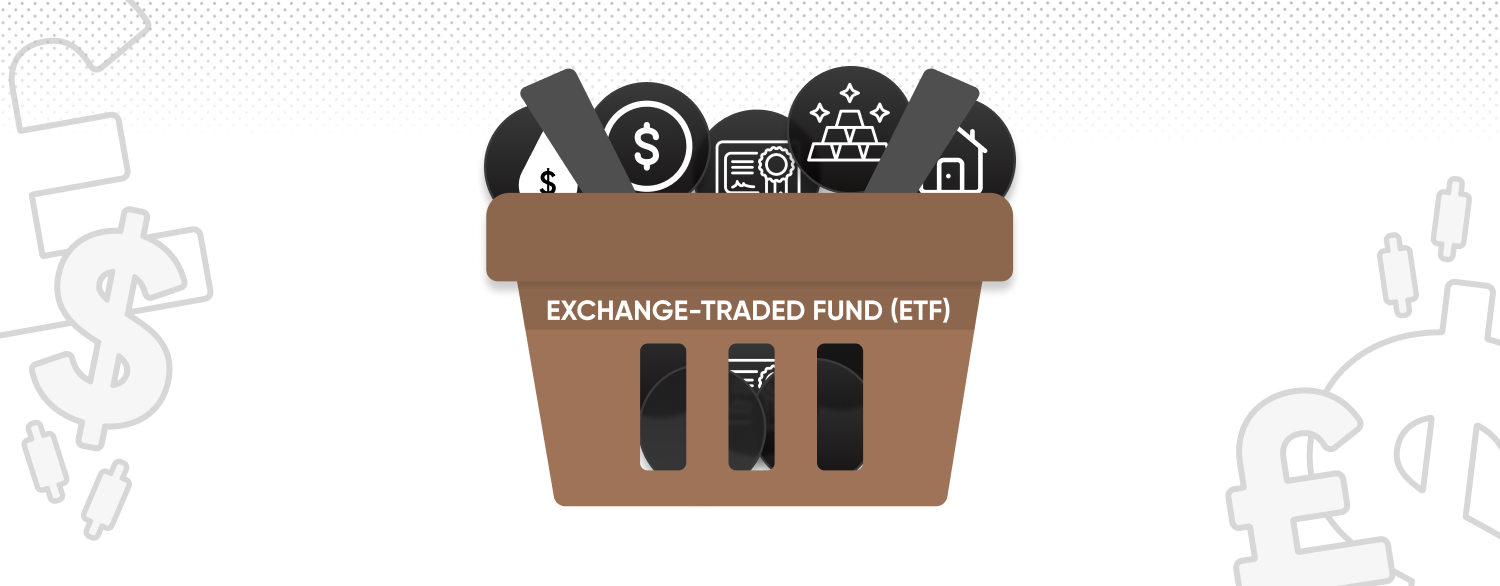What Is an ETF? Understanding the Basics of Exchange-Traded Funds

Exchange traded fund (ETF) is a useful instrument in an investor’s arsenal. Yet what’s the mechanics behind this investing vehicle and how do the ETFs work? Here we take a look at the ETF definition.
What is an ETF?
An exchange traded fund (ETF) is a fund designed to track a particular group of shares, bonds, commodities, derivative products or other assets. In essence, an ETF is a basket of securities that trades on an exchange.
Highlights
-
ETFs are baskets of securities that trade on exchanges.
-
ETFs can consist of a group of various asset classes, including shares, bonds, commodities, and more.
-
There are different types of ETFs such as index-tracking, regional, currency or commodity-based, sector and industry tracking, leveraged and inverse.
-
Benefits of ETFs include diversification, ownership of an asset and that they may involve less transactions than trading assets individually.
-
Risks of ETFs include (but not limited to) market and shutdown risks, and tracking errors.
How do ETFs work
An ETF is a type of fund that is based on various assets, such as stocks, bonds, commodities and others, and divides ownership of itself into shares that are held by shareholders. The details of the ETF structure usually vary by country or even region of a country.
The shareholders indirectly own the assets of the fund, and they will typically get an annual report. Shareholders are entitled to a share of the profits, such as dividends or interest, and they may get a residual value in case the fund is liquidated. Their ownership interest in the fund can easily be sold and bought.
ETFs don’t redeem or sell their individual shares at net asset value (NAV). Instead, financial institutions purchase and redeem ETF shares directly from the ETF, but only in large blocks, known as creation units.
The ability to purchase and redeem creation units gives ETFs an arbitrage mechanism intended to minimise the potential deviation between the market price and the NAV of ETF shares.

ETFs vs mutual funds
Mutual funds and ETFs are both baskets of securities, yet the way the two instruments trade is significantly different.
Unlike mutual funds, you can trade ETFs on stock exchanges at any time during the trading session, rather than once at the end of the day. An ETF meaning is that of marketable security, which means that its price will change throughout the trading day.
Mutual funds, on the other hand, can only be bought at the end of the end of the trading day after markets close.
Different types of ETFs explained
There are various ETF types investors and traders can choose from. These types can be based on the asset class of the ETF’s components, their geography, industry selection, and other themes.
| Stock index ETF | Tracks the performance of a stock index. For example, SPDR S&P 500 ETF Trust (SPY) is one of the many ETFs that tracks the performance of S&P 500 (US500), the US benchmark stock index. |
| Currency ETF | Mimic performance of a currency or a basket of currencies and provide traders with exposure to the forex market. |
| Sector and industry ETF | Track an index of companies within the same industry. For example, nanotechnology or clean energy ETFs. |
| Geographic ETF | Track assets in a specific country or region, for example, European stocks or US bonds. |
| Leveraged ETF | Use financial derivatives and debt as leverage to amplify the potential returns of an underlying index. Note that leverage can magnify both profits and losses. |
| Commodity ETF | Invested in physical commodities, such as agricultural goods, natural resources, precious metals, and more. |
| Inverse/short ETF | Grows in value - if its benchmark falls in value. This is essentially a way of short-selling via ETFs. |
Active vs Passive ETFs explained
Passive ETFs typically track an index, hence the components of a passive ETFs will always reflect its benchmark. Index-tracking ETFs can be used as a form of passive investing, a hands-off approach where investors rely on broader benchmark performance to generate returns on their portfolios.
Active ETFs, on the other hand, typically involve an investment manager, who pro-actively chooses the fund’s components to beat a benchmark (generate higher returns), and is a form of active investing. Active funds may involve a higher management fee since there is an actual investment professional managing a fund.
Benefits of ETFs
-
Diversification: ETFs allow investors to hold a variety of assets in one fund, hence they increase portfolio’s diversification.
-
Ownership of the asset: ETFs imply ownership of the underlying assets they consist of. For example, a stock ETF’s holders would be entitled to shareholder rights such as dividend payments.
-
Less transactions: ETFs allow investors to buy many assets in one trade, hence imply less transactions.
Risks of ETFs
-
Market risk: There is always a market risk when trading ETFs. Remember, markets are unpredictable and can go up and down. You should conduct your own due diligence before trading.
-
Tracking error: Although ETFs tracking errors are rare, and typically insignificant, they can sometimes accumulate to a gap of several percentage points between a fund’s performance and its benchmark.
-
Shutdown risk: While ETFs are extremely popular overall, there are still some funds that lack love from investors. Low-demand funds may be liquidated, and although shareholders will get paid in cash, the process may be very uncomfortable.
Conclusion
ETFs are baskets of securities that trade on exchanges in the same manner as stocks do. That’s their main difference from mutual funds, which can only be bought at the end of the trading day.
Investors can choose between a wide variety of ETF types including index-tracking funds, currency and commodity ETFs, sector-specific and regional funds, leveraged and inverse. Active ETFs are managed by an investment manager and may involve a higher fee, while passive ETFs typically track a benchmark.
ETFs can provide diversification and may be suitable for those investors who want to own the underlying asset, plus want to be involved in less transactions. However, there are also risks to ETFs, such as market and shutdown risks, tracking errors, and more.
FAQs
How do ETFs work?
The ETF shareholders indirectly own the assets of the fund, and they will typically get an annual report. Shareholders are entitled to a share of the profits, such as dividends or interest, and they may get a residual value in case the fund is liquidated. Their ownership interest in the fund can easily be sold and bought.
ETFs don’t redeem or sell their individual shares at net asset value (NAV). Instead, financial institutions purchase and redeem ETF shares directly from the ETF, but only in large blocks, known as creation units.
The ability to purchase and redeem creation units gives ETFs an arbitrage mechanism intended to minimise the potential deviation between the market price and the NAV of ETF shares.
What is an ETF account?
An ETF account is a trading account that holds exchange traded funds (ETFs).
How many ETFs are there?
According to Statista, there were 8,754 ETFs globally in 2022.